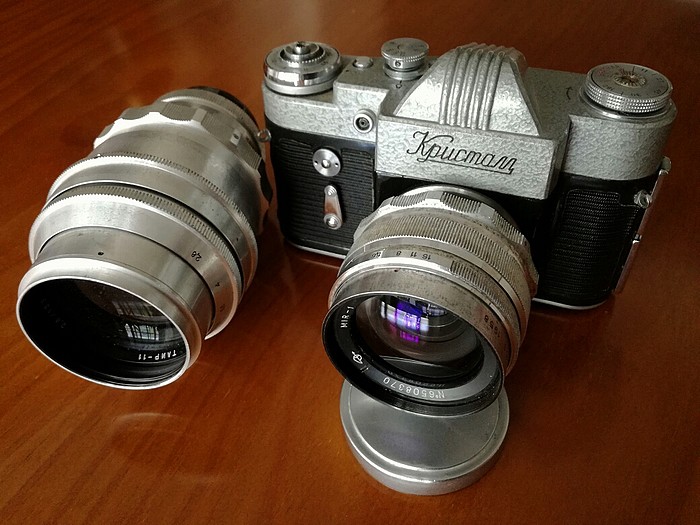webOSUser
Well-known
Colton,
I am sorry to hear that.
Your photographs are an inspiration to me.
Steve W
I am sorry to hear that.
Your photographs are an inspiration to me.
Steve W
I'm a bit bummed as I won't be able to participate this year. My Zorki 4 is one of my favorite cameras, and in recent years I really enjoyed participating in RFF's Red Oktober.
Unfortunately I'm no longer able to go out and shoot so can't participate.
I'll keep an eye on this thread though, and look forward to what everyone shares
webOSUser
Well-known
You can read my friend Alex’s review of this film here:
http://www.alexluyckx.com/blog/index.php/2020/04/13/film-review-blog-no-58-svema-foto-fn64/
Thank you for the information. I have shot the modern incarnation of the film in 35mm and enjoyed it.
Steve W
webOSUser
Well-known
Shoot it at box speed or 32. I would develop it in Rodinal 1:50 for 11 or 12 minutes. Give it a good presoak before developing, changing the water several times, a big issue with the old Soviet 120 films is transference of fibers from the backing paper to the non-emulsion side of the film.
Thank you for the advice. It will help when I develope this roll.
Steve W
David Hughes
David Hughes
Really, it was in November? Which calendar had it that way? I have this theory that October was meant to be in the 8th month, because oct means eight; September was the seventh month, because sept means seven, November the ninth month, since "no" or "nov" prefix means nine; and December is then the tenth month since dec means "decade" or ten. The eleventh month would then be January, and February would be the twelfth month. That way, the new year would start in the springtime in March. Spring is a renewal of life, so it seems logical for it to be the beginning of the year.
But I don't know if there was ever a calendar that had it that way. Was there a Russian calendar that October as the eleventh month, or how did it go?
Apologies but I sat through Latin lessons for years and thought it a waste of time; so now I get the chance to use it.
Seven, Eight, Nine and Ten in Latin are Septem, Octo, Novem and Decem.
Some names are derived from Latin numbers; f'instance Secunda and Septimus and Secundus for the second (female), seventh (male) and second (male). We were told that only the first born had a proper name the rest had numbers.
Regards, David
PS And you're lucky that I forgot how to write dates in Latin although we all know about the ides of March...
farlymac
PF McFarland
Strictly from Former Soviet Union ??
Or can we use Former Eastern Block stuff ??
I think of Pentacon lenses or Flexaret TLRs....
Regards
Joao
Eastern Block and Communist China gear are acceptable.
PF
David Hughes
David Hughes
What cut off dates?
German unification and the Long March are totally different dates...
Regards, David
German unification and the Long March are totally different dates...
Regards, David
Swift1
Mentor
We'll be keeping you in our thoughts, Colton, and hope to put up some typical output for your enjoyment.
PF
I am sorry to hear that Colton. Your work has always inspired me and I will miss your participation.
Colton,
I am sorry to hear that.
Your photographs are an inspiration to me.
Steve W
Thanks guys
I'll be looking forward to seeing what everyone posts here.
farlymac
PF McFarland
What cut off dates?
German unification and the Long March are totally different dates...
Regards, David
The Fall of the Soviet Union (December 31, 1991) is considered the cut-off for any FSU or Soviet Block states. For Chinese made cameras it's kind of open ended, so I refer you to this site for inspiration. And long lists of camera brands.
PF
valdas
Mentor
Well, I guess I’ll shoot a roll with my Kiev. Maybe even Redscale...
David Hughes
David Hughes
The Fall of the Soviet Union (December 31, 1991) is considered the cut-off for any FSU or Soviet Block states. For Chinese made cameras it's kind of open ended, so I refer you to this site for inspiration. And long lists of camera brands.
PF
That was the point of my question...
Regards, David
farlymac
PF McFarland
That was the point of my question...
Regards, David
Well, I don't think you can count any "Made In China" Nikon gear in with the FSU stuff.
Cameras that are native to China, and made in the same time frame as the FSU requirement are acceptable, though it may be hard to determine actual manufacture dates on certain models. Just use the aforementioned site as a guide to what is acceptable.
PF
Joao
Negativistic forever
James1
Established
If you're into making your own developers, the time on the box is for ST-2 which is a simple metol-based standard Soviet developer.
Otherwise, I would try something like D-76; at least in my experience Soviet films work best with M or MQ developers. I would say shoot at EI32 or 16.
Otherwise, I would try something like D-76; at least in my experience Soviet films work best with M or MQ developers. I would say shoot at EI32 or 16.
I bought a roll of Svema Foto 64 with an expiration date of March 1990 so it is within the date range of Red Oktober. Any suggestions on how to expose it? EI of 8 ISO maybe? .
Svema Foto 64 Exp 0390 by Steven Wagner, on Flickr
farlymac
PF McFarland
webOSUser
Well-known
My thinks for suggestions on how to shoot and develop the 1990 Svena Foto 64.
I shot it last weekend in my Moskva 4 at an EI of 32. And developed it today in Rodinal 1:50 for about 11 1/2 minutes. The negatives are rather thin and the scanned images are not very detailed.
Here is one of the images: Tenent House Historic Oak View Cty Park by Steven Wagner, on Flickr
Tenent House Historic Oak View Cty Park by Steven Wagner, on Flickr
I shot it last weekend in my Moskva 4 at an EI of 32. And developed it today in Rodinal 1:50 for about 11 1/2 minutes. The negatives are rather thin and the scanned images are not very detailed.
Here is one of the images:
 Tenent House Historic Oak View Cty Park by Steven Wagner, on Flickr
Tenent House Historic Oak View Cty Park by Steven Wagner, on FlickrLarry Cloetta
Mentor
webOSUser
Well-known
I love how the light shines on the trees in the top half of the picture.
Steve
Steve
Larry Cloetta
Mentor
I love how the light shines on the trees in the top half of the picture.
Steve
Thank you, Steve.
farlymac
PF McFarland
What Steve said!
PF
PF
Larry Cloetta
Mentor
What Steve said!
PF
Thank you! First time I have ever tried shooting slide film in it, and was pleasantly surprised, even if they were not all keepers.
Share:
-
This site uses cookies to help personalise content, tailor your experience and to keep you logged in if you register.
By continuing to use this site, you are consenting to our use of cookies.









